Tigers roar with power and mystique in Chinese art. They captivate art enthusiasts with their raw beauty and symbolismSymbolism was a late 19th-century art movement of French, Belgian, and Russian origin. Poets and fine artists were seeking to represent absolute truths using metaphorical images in reaction against realism and naturalism. Content of both images and poetry were suggestive contents to express mystical ideas, emotions, and states of mind. Paul Gauguin, Nave Nave Mahana (1869) The term was coined More.
These majestic animals embody strength, protection, and bravery, making them central figures in Chinese cultural narratives. From the detailed strokes of ancient scrolls to bold modern tattoos, the tiger’s image has evolved while retaining its core significance.
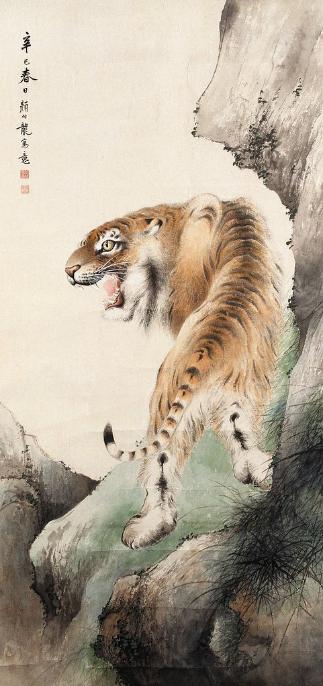
Artists have celebrated the tiger’s regal presence in many mediums to create masterpieces that blend tradition with contemporary flair. The legendary white tiger and the fierce dragon-tiger duo are just two examples of how tigers are represented, each piece telling a story of courage and reverence.
So, let’s learn more about Chinese tiger art, where each artwork reveals a tale of power. You’ll discover the rich heritage that bring these tigers to life.
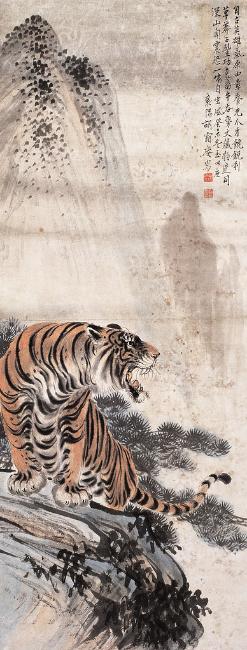
Historical Context of Tigers in Chinese Art
Tigers have prowled through Chinese mythologyMythology in art taps into the rich stories and symbols from ancient cultures. These narratives shape our understanding of history, morality, and human nature, offering a profound connection between the past and the present. From the ancient Greeks to the Norse sagas, mythological themes have deeply influenced artistic expression. Greek Mythology Greek mythology is one of the most popular sources More and folkloreFolklore in art draws from the rich oral traditions, legends, and customs passed down through generations. These stories and motifs provide a window into the cultural identity and collective wisdom of various communities, making them a vital source of inspiration for artists worldwide. European Folklore European folklore encompasses a wide array of tales and characters that have left a lasting More for centuries, revered as powerful and protective beings.
In ancient China, tigers were seen as the king of all animals, embodying the essence of strength and authority. Legends often depicted them as fierce guardians who warded off evil spirits and brought good fortune.
Historical texts and artifacts frequently illustrate tigers in battle scenes and mythological narratives, underscoring their role in cultural heritage.
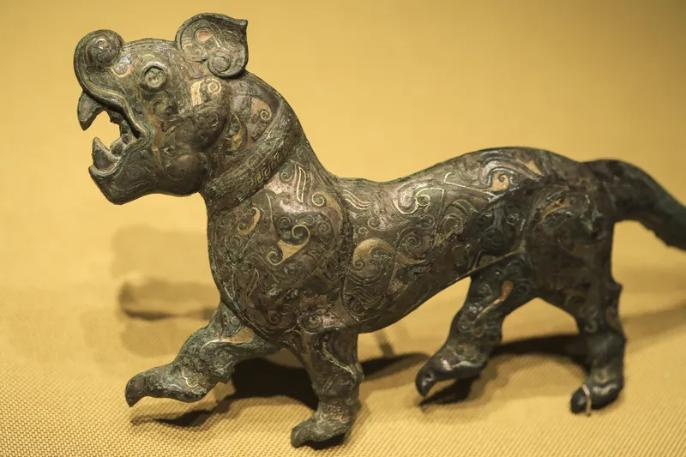
Symbolic Meanings of Tigers in Chinese Art
In Chinese culture, tigers symbolize physical power, courage, protection, and dominance. They are one of the Four Symbols in Chinese mythologyMythology in art taps into the rich stories and symbols from ancient cultures. These narratives shape our understanding of history, morality, and human nature, offering a profound connection between the past and the present. From the ancient Greeks to the Norse sagas, mythological themes have deeply influenced artistic expression. Greek Mythology Greek mythology is one of the most popular sources More, which are celestial guardians representing the cardinal directions.
The tiger is associated with the West and the season of autumn. The other three symbols include the Azure Dragon of the East, the Vermilion Bird of the South and the Black Tortoise of the North.
Tigers are believed to protect the living and the deceased and are often depicted in the context of tombs to guard against evil spirits.

Traditional Chinese Tiger Art
From ancient relics to masterful inkInk, a liquid or paste used for writing, drawing, and printing, has played a crucial role in communication and artistic expression throughout history. Made from various pigments and dyes, ink allows for the transfer of text and images onto surfaces such as paper, fabric, and other materials. Types of Ink There are several types of ink, each serving different purposes More paintings, the portrayal of tigers in Chinese artChinese art encompasses a vast array of forms and influences. It has a rich history that dates back over 5,000 years and is characterized by unique regional, philosophical, and political influences that have evolved over millennia. Ancient Era The origins of Chinese art trace back to prehistoric times, highlighted by significant archaeological discoveries. These findings include pottery, jade carvings, and More has evolved while maintaining its cultural significance.
Ancient Tiger Representations
In ancient Chinese artChinese art encompasses a vast array of forms and influences. It has a rich history that dates back over 5,000 years and is characterized by unique regional, philosophical, and political influences that have evolved over millennia. Ancient Era The origins of Chinese art trace back to prehistoric times, highlighted by significant archaeological discoveries. These findings include pottery, jade carvings, and More, tigers appeared as powerful and majestic creatures. They symbolized protection and strength.
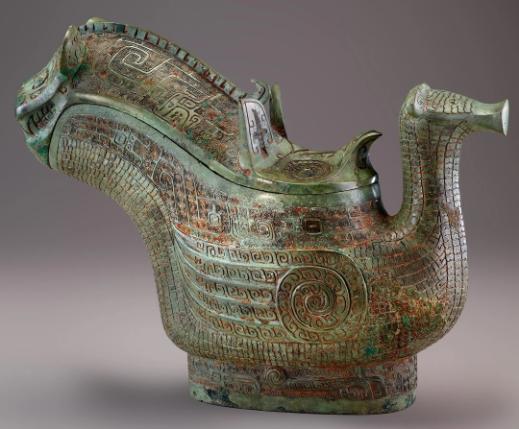
These images can be found on historical artifacts, such as bronze vessels, jadeJade, a precious gemstone highly esteemed in various cultures, particularly in East Asia, symbolizes purity, serenity, and longevity. It has been used for thousands of years in art, jewelry, and ritual objects. Types of Jade There are two primary types of jade, each with distinct characteristics and sources. Unworked jade Nephrite • Composition: Composed mainly of calcium, magnesium, and iron. More carvings, and potteryPottery, one of the most ancient and functional art forms, bridges the gap between utilitarian objects and expressive artwork. This craft has been practiced for thousands of years, evolving across cultures and epochs. The world of pottery is vast and varied, ranging from simple earthenware to ornate porcelain. Chinese Ming dynasty blue-and-white porcelain dish with a dragon The Basics of More from the Shang (1600 to 1046 BCE) and Zhou dynasties (1046 to 256 BCE). Notable examples include bronze tiger sculptures from the Shang dynasty, used in rituals to invoke the spirit of the tiger. These early representations featured bold lines and a stylized approach that captured the tiger’s fierce and regal nature.
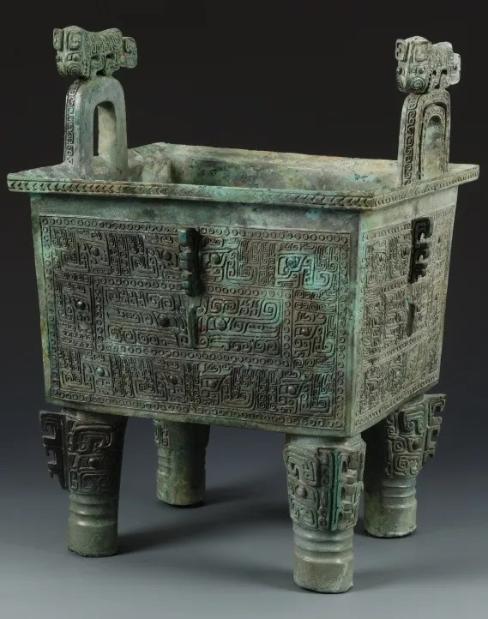
Techniques and Styles of Tiger Painting
Traditional Chinese tiger art employed several techniques that brought the subject to life. Brushwork and inkInk, a liquid or paste used for writing, drawing, and printing, has played a crucial role in communication and artistic expression throughout history. Made from various pigments and dyes, ink allows for the transfer of text and images onto surfaces such as paper, fabric, and other materials. Types of Ink There are several types of ink, each serving different purposes More paintingPainting is a fundamental form of visual art that has been practiced for thousands of years. It involves applying pigment to a surface such as canvas, paper, or a wall. Painting can be explored through various styles, techniques, and mediums, each offering unique possibilities for expression and creativity. Historical Background • Ancient Beginnings: The history of painting dates back to More are two primary methods.
- BrushworkMasterful brushwork is often the defining feature of great artists, where the brush becomes an extension of their arm, allowing paint to flow effortlessly onto the canvas. These artists demonstrate a profound understanding of their medium, knowing precisely when to apply thick, textured strokes or smooth, delicate ones. Their skill extends beyond mere color application; it's about the artistry of More: Artists used various brushstrokes to capture the tiger’s essence, from its fluid movement to its powerful stance. The brushworkMasterful brushwork is often the defining feature of great artists, where the brush becomes an extension of their arm, allowing paint to flow effortlessly onto the canvas. These artists demonstrate a profound understanding of their medium, knowing precisely when to apply thick, textured strokes or smooth, delicate ones. Their skill extends beyond mere color application; it's about the artistry of More ranged from fine lines to bold, sweeping strokes, each contributing to the piece’s dynamism.
- InkInk, a liquid or paste used for writing, drawing, and printing, has played a crucial role in communication and artistic expression throughout history. Made from various pigments and dyes, ink allows for the transfer of text and images onto surfaces such as paper, fabric, and other materials. Types of Ink There are several types of ink, each serving different purposes More PaintingPainting is a fundamental form of visual art that has been practiced for thousands of years. It involves applying pigment to a surface such as canvas, paper, or a wall. Painting can be explored through various styles, techniques, and mediums, each offering unique possibilities for expression and creativity. Historical Background • Ancient Beginnings: The history of painting dates back to More: This technique used different shadesIn color theory, a shade is a darker version of a color, created by adding black to the original hue. This concept is essential for artists and designers, as it allows for a range of deeper, more intense tones that can add depth and drama to a composition. Defining Shade A shade results from mixing a pure hue with black. More of inkInk, a liquid or paste used for writing, drawing, and printing, has played a crucial role in communication and artistic expression throughout history. Made from various pigments and dyes, ink allows for the transfer of text and images onto surfaces such as paper, fabric, and other materials. Types of Ink There are several types of ink, each serving different purposes More to create depth and texture. Artists combined light and dark inks to depict the tiger’s fur, muscles, and expression.
These traditional techniques highlight the tiger’s importance in Chinese culture. The resulting artworks were visual representations and cultural treasures that conveyed the tiger’s legacy in Chinese artChinese art encompasses a vast array of forms and influences. It has a rich history that dates back over 5,000 years and is characterized by unique regional, philosophical, and political influences that have evolved over millennia. Ancient Era The origins of Chinese art trace back to prehistoric times, highlighted by significant archaeological discoveries. These findings include pottery, jade carvings, and More.
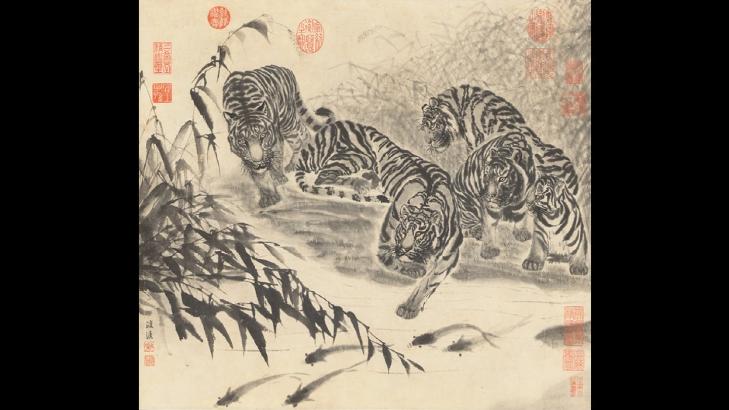
Chinese Tiger Tattoos
Chinese tiger tattoos have become a powerful statement in modern body art, where they fuse ancient symbolismSymbolism was a late 19th-century art movement of French, Belgian, and Russian origin. Poets and fine artists were seeking to represent absolute truths using metaphorical images in reaction against realism and naturalism. Content of both images and poetry were suggestive contents to express mystical ideas, emotions, and states of mind. Paul Gauguin, Nave Nave Mahana (1869) The term was coined More with contemporary style. These tattoos resonate with people who seek the tiger’s attributes of strength, courage, and protection.

Tiger Tattoo Trends
The popularity of tiger tattoos inspired by Chinese artChinese art encompasses a vast array of forms and influences. It has a rich history that dates back over 5,000 years and is characterized by unique regional, philosophical, and political influences that have evolved over millennia. Ancient Era The origins of Chinese art trace back to prehistoric times, highlighted by significant archaeological discoveries. These findings include pottery, jade carvings, and More reflects a growing appreciation for traditional motifs in modern tattoo culture.
These tattoos are both body art and emblems of personal identity and cultural heritage. The striking imagery and deeper meanings associated with the tiger make these tattoos particularly appealing.
People are drawn to the boldness and the rich narratives that Chinese tiger tattoos express.
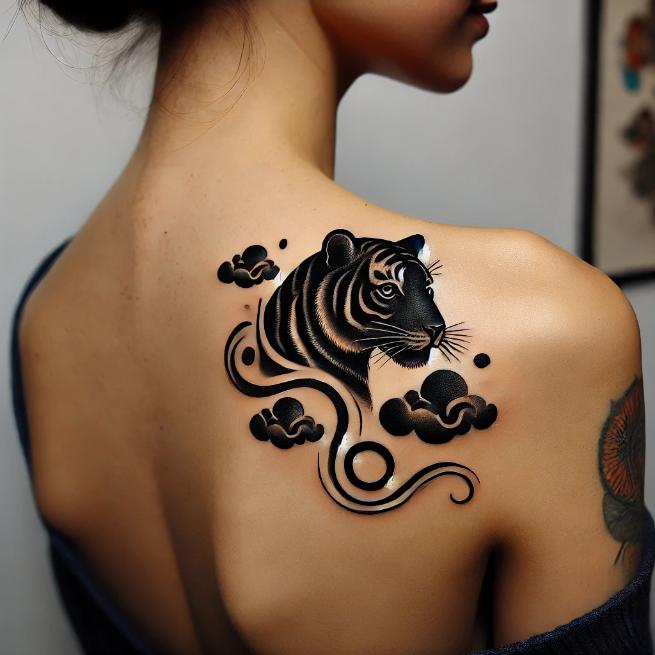
Tiger Tattoo Design Elements
Chinese tiger tattoos often feature detailed designs that carry their own significance. Common elements include:
- Dragons: The combination of tigers and dragons is a popular motif, symbolizing the balance between power and wisdom. The dragon represents knowledge and control, which complements the tiger’s raw strength and courage. This duo embodies the harmonious interplay of opposing forces.
- Clouds and Waves: These elements add a sense of movement and depth to the tattoo. Clouds symbolize the heavens or give a mystical aura, while waves suggest the tiger’s command over its surroundings.
- CalligraphyCalligraphy, the art of beautiful writing, has been practiced for centuries across various cultures. This artistic form of writing emphasizes the aesthetic presentation of letters and symbols, combining skillful penmanship with artistic expression. Historical Overview • Origins: Ancient civilizations such as China, Egypt, and Rome • Chinese Calligraphy: Developed around 2000 BC, using brush and ink • Islamic Calligraphy: Flourished More: Adding Chinese characters can infuse the tattoo with additional layers of meaning, often representing virtues like bravery, strength, or protection. This personalization makes the tattoo uniquely significant to the wearer.
Each element in a Chinese tiger tattoo contributes to a layered narrative that speaks to both personal and cultural stories. This blend of tradition and individual expression makes Chinese tiger tattoos a captivating choice for many.
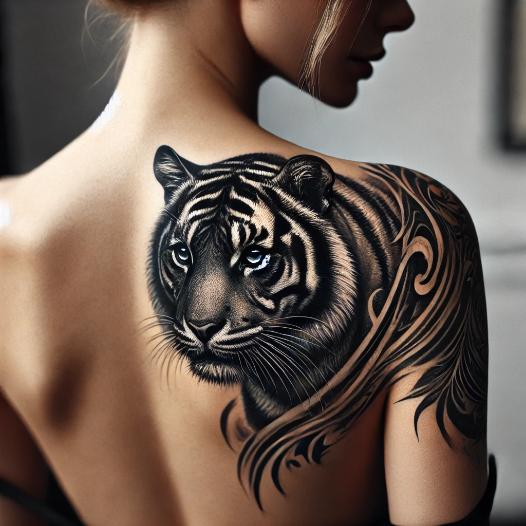
Innovative Interpretations in Chinese Tiger Art
As artists push boundaries, the tiger in Chinese artChinese art encompasses a vast array of forms and influences. It has a rich history that dates back over 5,000 years and is characterized by unique regional, philosophical, and political influences that have evolved over millennia. Ancient Era The origins of Chinese art trace back to prehistoric times, highlighted by significant archaeological discoveries. These findings include pottery, jade carvings, and More undergoes fascinating transformations. These changes merge age-old traditions with contemporary creativity.
Modern Chinese Artists’ Tiger Images
Several contemporary artists have contributed to the portrayal of tigers in Chinese artChinese art encompasses a vast array of forms and influences. It has a rich history that dates back over 5,000 years and is characterized by unique regional, philosophical, and political influences that have evolved over millennia. Ancient Era The origins of Chinese art trace back to prehistoric times, highlighted by significant archaeological discoveries. These findings include pottery, jade carvings, and More by blending traditional techniques with modern themes.
- Cai Guo-QiangCai Guo-Qiang is a Chinese contemporary artist known for his innovative use of gunpowder and explosives in his art. His works, which span installation, drawing, and performance art, often explore themes of destruction and creation, cultural history, and the human experience. Cai's art is characterized by its dramatic impact and profound messages. Early Life and Influences Cai Guo-Qiang was born More: Known for his “explosive” art, Cai Guo-QiangCai Guo-Qiang is a Chinese contemporary artist known for his innovative use of gunpowder and explosives in his art. His works, which span installation, drawing, and performance art, often explore themes of destruction and creation, cultural history, and the human experience. Cai's art is characterized by its dramatic impact and profound messages. Early Life and Influences Cai Guo-Qiang was born More often uses gunpowder to create dynamic and dramatic pieces. His work “Head On” features tigers among other animals in a powerful and striking installation, merging traditional motifs with modern artistic practices.
- Zhang DaqianZhang Daqian, also known as Chang Dai-chien, is one of the most influential Chinese artists of the 20th century. Renowned for his versatility and technical mastery, Zhang’s work spans traditional Chinese painting, modern art, and innovative techniques. His ability to blend traditional and contemporary styles has cemented his legacy as a pivotal figure in modern Chinese art. Early Life and More: A renowned Chinese painter, Zhang DaqianZhang Daqian, also known as Chang Dai-chien, is one of the most influential Chinese artists of the 20th century. Renowned for his versatility and technical mastery, Zhang’s work spans traditional Chinese painting, modern art, and innovative techniques. His ability to blend traditional and contemporary styles has cemented his legacy as a pivotal figure in modern Chinese art. Early Life and More has created numerous tiger paintings that showcase his mastery of traditional Chinese brushworkMasterful brushwork is often the defining feature of great artists, where the brush becomes an extension of their arm, allowing paint to flow effortlessly onto the canvas. These artists demonstrate a profound understanding of their medium, knowing precisely when to apply thick, textured strokes or smooth, delicate ones. Their skill extends beyond mere color application; it's about the artistry of More. His tigers are often depicted in natural settings, blending realismRealism is an art movement that emerged in the mid-19th century, emphasizing the depiction of subjects as they appear in everyday life. It rejects the idealized forms and dramatic expressions of Romanticism, focusing instead on accuracy, truthfulness, and the mundane aspects of the human experience. Realism strives to capture the world in a straightforward and unembellished manner. Gustave Courbet, The More with traditional Chinese artChinese art encompasses a vast array of forms and influences. It has a rich history that dates back over 5,000 years and is characterized by unique regional, philosophical, and political influences that have evolved over millennia. Ancient Era The origins of Chinese art trace back to prehistoric times, highlighted by significant archaeological discoveries. These findings include pottery, jade carvings, and More techniques.
Cultural Fusion in Tiger Art
Modern tiger art showcases a blend of Chinese and Western influences, bringing out the best of both worlds.
Artists integrate Western realismRealism is an art movement that emerged in the mid-19th century, emphasizing the depiction of subjects as they appear in everyday life. It rejects the idealized forms and dramatic expressions of Romanticism, focusing instead on accuracy, truthfulness, and the mundane aspects of the human experience. Realism strives to capture the world in a straightforward and unembellished manner. Gustave Courbet, The More and abstract art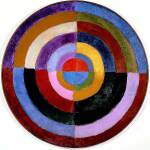 Abstract artworks diverge from depicting recognizable scenes or objects and instead use colors, forms, and lines to create compositions that exist independently of visual references from the natural world. This movement, which gained momentum in the early 20th century, was propelled by artists such as Wassily Kandinsky, Piet Mondrian, and Kazimir Malevich. These artists aimed to explore spiritual, emotional, and More with traditional Chinese brushworkMasterful brushwork is often the defining feature of great artists, where the brush becomes an extension of their arm, allowing paint to flow effortlessly onto the canvas. These artists demonstrate a profound understanding of their medium, knowing precisely when to apply thick, textured strokes or smooth, delicate ones. Their skill extends beyond mere color application; it's about the artistry of More and symbolismSymbolism was a late 19th-century art movement of French, Belgian, and Russian origin. Poets and fine artists were seeking to represent absolute truths using metaphorical images in reaction against realism and naturalism. Content of both images and poetry were suggestive contents to express mystical ideas, emotions, and states of mind. Paul Gauguin, Nave Nave Mahana (1869) The term was coined More, creating vibrant artworks that appeal to a global audience.
Abstract artworks diverge from depicting recognizable scenes or objects and instead use colors, forms, and lines to create compositions that exist independently of visual references from the natural world. This movement, which gained momentum in the early 20th century, was propelled by artists such as Wassily Kandinsky, Piet Mondrian, and Kazimir Malevich. These artists aimed to explore spiritual, emotional, and More with traditional Chinese brushworkMasterful brushwork is often the defining feature of great artists, where the brush becomes an extension of their arm, allowing paint to flow effortlessly onto the canvas. These artists demonstrate a profound understanding of their medium, knowing precisely when to apply thick, textured strokes or smooth, delicate ones. Their skill extends beyond mere color application; it's about the artistry of More and symbolismSymbolism was a late 19th-century art movement of French, Belgian, and Russian origin. Poets and fine artists were seeking to represent absolute truths using metaphorical images in reaction against realism and naturalism. Content of both images and poetry were suggestive contents to express mystical ideas, emotions, and states of mind. Paul Gauguin, Nave Nave Mahana (1869) The term was coined More, creating vibrant artworks that appeal to a global audience.
- Wu GuanzhongWu Guanzhong, a towering figure in modern Chinese art, seamlessly blended traditional Chinese techniques with Western styles. His works encapsulate the soul of Chinese landscapes and culture, while reflecting contemporary aesthetics. Early Life and Education Wu was born in 1919 in Yixing, Jiangsu province. His passion for art was evident from a young age. After attending the National Arts Academy More: Known for merging Chinese inkInk, a liquid or paste used for writing, drawing, and printing, has played a crucial role in communication and artistic expression throughout history. Made from various pigments and dyes, ink allows for the transfer of text and images onto surfaces such as paper, fabric, and other materials. Types of Ink There are several types of ink, each serving different purposes More paintingPainting is a fundamental form of visual art that has been practiced for thousands of years. It involves applying pigment to a surface such as canvas, paper, or a wall. Painting can be explored through various styles, techniques, and mediums, each offering unique possibilities for expression and creativity. Historical Background • Ancient Beginnings: The history of painting dates back to More with Western abstract art
%22%20transform%3D%22translate(.5%20.5)%22%20fill-opacity%3D%22.5%22%3E%3Cellipse%20fill%3D%22%23fff%22%20rx%3D%221%22%20ry%3D%221%22%20transform%3D%22rotate(49.5%20-73.5%20216.4)%20scale(22.32723%2041.18916)%22%2F%3E%3Cellipse%20fill%3D%22%2360313a%22%20cx%3D%2272%22%20cy%3D%2276%22%20rx%3D%2261%22%20ry%3D%2261%22%2F%3E%3Cellipse%20fill%3D%22%23fff%22%20rx%3D%221%22%20ry%3D%221%22%20transform%3D%22rotate(-131.7%2070.2%20-26.1)%20scale(108.88858%2017.91884)%22%2F%3E%3Cellipse%20fill%3D%22%23fff%22%20rx%3D%221%22%20ry%3D%221%22%20transform%3D%22rotate(-131.1%2036.5%2066.6)%20scale(60.55413%2017.0478)%22%2F%3E%3C%2Fg%3E%3C%2Fsvg%3E) Abstract artworks diverge from depicting recognizable scenes or objects and instead use colors, forms, and lines to create compositions that exist independently of visual references from the natural world. This movement, which gained momentum in the early 20th century, was propelled by artists such as Wassily Kandinsky, Piet Mondrian, and Kazimir Malevich. These artists aimed to explore spiritual, emotional, and More, Wu Guanzhong’s works often include tigers and other elements from nature. His pieces blend the fluidity and expressiveness of traditional Chinese techniques with the boldness of abstract modernismThe term Modernism refers to a global movement in society and culture which sought the departure from traditional forms of thinking in favour of the creation of new forms of art, philosophy, and social organisation. Reflecting the transformations in western society during the late 19th and early 20th centuries and the newly emerging industrial world provided the impetus to depart More.
Abstract artworks diverge from depicting recognizable scenes or objects and instead use colors, forms, and lines to create compositions that exist independently of visual references from the natural world. This movement, which gained momentum in the early 20th century, was propelled by artists such as Wassily Kandinsky, Piet Mondrian, and Kazimir Malevich. These artists aimed to explore spiritual, emotional, and More, Wu Guanzhong’s works often include tigers and other elements from nature. His pieces blend the fluidity and expressiveness of traditional Chinese techniques with the boldness of abstract modernismThe term Modernism refers to a global movement in society and culture which sought the departure from traditional forms of thinking in favour of the creation of new forms of art, philosophy, and social organisation. Reflecting the transformations in western society during the late 19th and early 20th centuries and the newly emerging industrial world provided the impetus to depart More.
- Yan Pei-MingYan Pei-Ming, a contemporary Chinese-French artist, is renowned for his large-scale, monochromatic portraits. His powerful brushwork and dramatic compositions capture the essence of his subjects, ranging from political figures to ordinary people. Early Life and Education Born in Shanghai in 1960, Yan Pei-Ming grew up during the Cultural Revolution. His early experiences in this tumultuous period influenced his artistic perspective. More: A Chinese-born painter based in France, Yan Pei-MingYan Pei-Ming, a contemporary Chinese-French artist, is renowned for his large-scale, monochromatic portraits. His powerful brushwork and dramatic compositions capture the essence of his subjects, ranging from political figures to ordinary people. Early Life and Education Born in Shanghai in 1960, Yan Pei-Ming grew up during the Cultural Revolution. His early experiences in this tumultuous period influenced his artistic perspective. More is known for his large-scale, monochromatic portraits and animal paintings. His works often combine Western techniques with traditional Chinese themes, including powerful depictions of tigers that convey both cultural heritage and contemporary artistry.
We see how the image of the tiger in Chinese artChinese art encompasses a vast array of forms and influences. It has a rich history that dates back over 5,000 years and is characterized by unique regional, philosophical, and political influences that have evolved over millennia. Ancient Era The origins of Chinese art trace back to prehistoric times, highlighted by significant archaeological discoveries. These findings include pottery, jade carvings, and More remains vibrant and relevant. These contemporary interpretations honor traditional roots while exploring new artistic territories.
White Tiger Art in the Chinese Tradition
The white tiger features prominently in both Chinese mythologyMythology in art taps into the rich stories and symbols from ancient cultures. These narratives shape our understanding of history, morality, and human nature, offering a profound connection between the past and the present. From the ancient Greeks to the Norse sagas, mythological themes have deeply influenced artistic expression. Greek Mythology Greek mythology is one of the most popular sources More and art, inspiring a variety of creative interpretations.
Cultural Significance of the White Tiger
The white tiger holds a special place in Chinese mythologyMythology in art taps into the rich stories and symbols from ancient cultures. These narratives shape our understanding of history, morality, and human nature, offering a profound connection between the past and the present. From the ancient Greeks to the Norse sagas, mythological themes have deeply influenced artistic expression. Greek Mythology Greek mythology is one of the most popular sources More and culture. Known as Bai Hu (白虎), it is one of the Four Symbols. It represents the cardinal direction of the West and the season of autumn.
The white tiger symbolizes strength, courage, and the power to ward off evil. In Taoist traditions, it is believed to be the guardian of the western quadrant of the heavens.
The white tiger also embodies the metal element, representing purity and righteousness. Its presence in myth and legend highlights its role as a protector and a powerful spiritual symbol.
Artistic Representations of the White Tiger
Artists have long been fascinated by the white tiger, using various styles and colors to bring this mythical creature to life. Here are some examples of how the white tiger is represented in different artistic styles:
- Traditional InkInk, a liquid or paste used for writing, drawing, and printing, has played a crucial role in communication and artistic expression throughout history. Made from various pigments and dyes, ink allows for the transfer of text and images onto surfaces such as paper, fabric, and other materials. Types of Ink There are several types of ink, each serving different purposes More Paintings:
- Gao QifengGao Qifeng, a prominent Chinese painter, significantly impacted modern Chinese art through his innovative blend of traditional techniques and modern sensibilities. Known for his evocative depictions of animals and nature, Gao's work bridges the gap between classical Chinese painting and contemporary art. Early Life and Education Born in 1889 in Panyu, Guangdong province, Gao Qifeng came from a family of More: A painter from the Lingnan school, Gao QifengGao Qifeng, a prominent Chinese painter, significantly impacted modern Chinese art through his innovative blend of traditional techniques and modern sensibilities. Known for his evocative depictions of animals and nature, Gao's work bridges the gap between classical Chinese painting and contemporary art. Early Life and Education Born in 1889 in Panyu, Guangdong province, Gao Qifeng came from a family of More is known for his meticulous brushworkMasterful brushwork is often the defining feature of great artists, where the brush becomes an extension of their arm, allowing paint to flow effortlessly onto the canvas. These artists demonstrate a profound understanding of their medium, knowing precisely when to apply thick, textured strokes or smooth, delicate ones. Their skill extends beyond mere color application; it's about the artistry of More and attention to detail. His paintingPainting is a fundamental form of visual art that has been practiced for thousands of years. It involves applying pigment to a surface such as canvas, paper, or a wall. Painting can be explored through various styles, techniques, and mediums, each offering unique possibilities for expression and creativity. Historical Background • Ancient Beginnings: The history of painting dates back to More “White Tiger” shows the tiger in a natural setting, using delicate brushstrokes to emphasize the fur’s texture and the animal’s majestic presence. Red accents in the background, such as autumn leaves or a setting sun, add a dramatic contrast to the white fur.
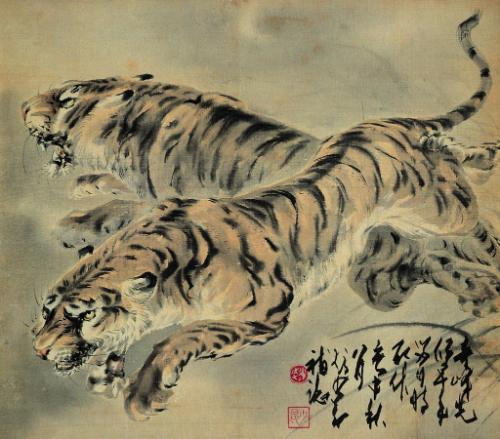
- Xu BeihongXu Beihong is one of the most influential figures in modern Chinese art. Renowned for his realistic oil paintings and expressive ink wash works, Xu played a pivotal role in blending Western techniques with traditional Chinese art. His work often focused on themes of patriotism, resilience, and the human spirit. Early Life and Influences Born in 1895 in Yixing, Jiangsu More: Famous for his realistic style and expressive brushworkMasterful brushwork is often the defining feature of great artists, where the brush becomes an extension of their arm, allowing paint to flow effortlessly onto the canvas. These artists demonstrate a profound understanding of their medium, knowing precisely when to apply thick, textured strokes or smooth, delicate ones. Their skill extends beyond mere color application; it's about the artistry of More, Xu Beihong’s “White Tiger” paintings capture the power and grace of the animal. His use of red highlights in the background enhances the overall impact of the artwork.
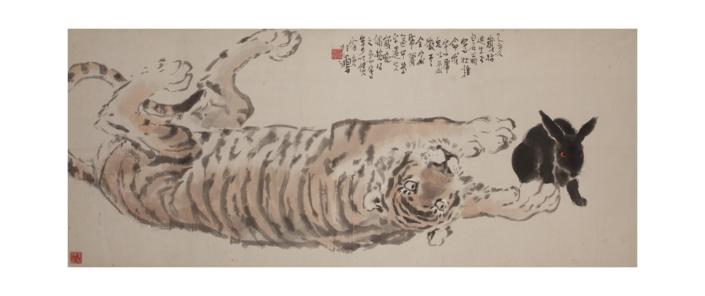
- Modern Interpretations:
- Yue MinjunYue Minjun is a celebrated contemporary Chinese artist known for his satirical self-portraits that often depict himself in various states of exaggerated laughter. His works are a blend of humor and critique, reflecting the complexities of modern Chinese society and the broader human experience. Early Life and Education Born in 1962 in Daqing, Heilongjiang province, Yue Minjun grew up during More: Known for his contemporary approach, Yue MinjunYue Minjun is a celebrated contemporary Chinese artist known for his satirical self-portraits that often depict himself in various states of exaggerated laughter. His works are a blend of humor and critique, reflecting the complexities of modern Chinese society and the broader human experience. Early Life and Education Born in 1962 in Daqing, Heilongjiang province, Yue Minjun grew up during More often incorporates traditional Chinese themes into his works. In some of his paintings, the white tiger is depicted with vibrant and contrasting colors, such as a vivid red background, symbolizing its protective power and dynamic energy.
- Mixed MediaMixed media involves combining various art materials and techniques within a single artwork. This approach allows artists to explore diverse textures, effects, and expressions. Basic Components of Mixed Media • Traditional Media: Includes paints, inks, and pencils. • Non-Traditional Media: Items like fabric, metal, and found objects. • Digital Elements: Incorporating digital prints or using software for certain effects. Techniques More:
- Yang YongliangYang Yongliang is a contemporary Chinese artist known for his innovative digital art that blends traditional Chinese aesthetics with modern urban landscapes. His works often comment on the rapid urbanization and environmental degradation in China, creating a dialogue between the past and present. Early Life and Education Born in 1980 in Shanghai, Yang Yongliang grew up witnessing the rapid transformation More: Yang YongliangYang Yongliang is a contemporary Chinese artist known for his innovative digital art that blends traditional Chinese aesthetics with modern urban landscapes. His works often comment on the rapid urbanization and environmental degradation in China, creating a dialogue between the past and present. Early Life and Education Born in 1980 in Shanghai, Yang Yongliang grew up witnessing the rapid transformation More combines traditional Chinese landscape paintingLandscape painting focuses on the depiction of natural scenery such as mountains, valleys, trees, rivers, and forests. It has been a significant genre in art history, evolving through various styles and periods. Landscape painting captures the beauty of the natural world and often reflects the cultural and philosophical views of the time. JMW Turner, Calais Pier, 1801 Historical Context Landscape More with digital media to create stunning images. In his series “The Tiger,” the white tiger is depicted with glowing eyes and ethereal landscapes, highlighting its mystical aura.
- Xu BingXu Bing is a renowned Chinese contemporary artist celebrated for his profound and thought-provoking installations, printmaking, and calligraphy. His works often explore themes of communication, language, and cultural identity, challenging the boundaries of traditional art forms and engaging audiences in meaningful dialogue. Early Life and Education Born in 1955 in Chongqing, China, Xu Bing grew up during the Cultural Revolution, More: Known for his innovative use of materials and techniques, Xu Bing’s mixed mediaMixed media involves combining various art materials and techniques within a single artwork. This approach allows artists to explore diverse textures, effects, and expressions. Basic Components of Mixed Media • Traditional Media: Includes paints, inks, and pencils. • Non-Traditional Media: Items like fabric, metal, and found objects. • Digital Elements: Incorporating digital prints or using software for certain effects. Techniques More works often feature tigers in imaginative settings. His piece “Tiger Carpet” uses traditional techniques and modern media, such as digital artDigital art refers to a range of artistic works and practices that use digital technology as an essential part of the creative or presentation process. Since the 1970s, various names have been used to describe the process, including computer art and multimedia art. Digital art is itself placed under the larger umbrella term of new media art. The digital art More and acrylicsAcrylics are a popular and versatile type of paint used in various art forms. Known for their vibrant colors and quick-drying properties, acrylic paints are favored by artists for their flexibility and ease of use. Historical Background • Invention and Early Use: Acrylic paint was first developed in the 1930s by chemists experimenting with synthetic resins. Initially used in industrial More, to create a unique representation of the white tiger.
These artistic representations highlight the appeal of the white tiger in Chinese artChinese art encompasses a vast array of forms and influences. It has a rich history that dates back over 5,000 years and is characterized by unique regional, philosophical, and political influences that have evolved over millennia. Ancient Era The origins of Chinese art trace back to prehistoric times, highlighted by significant archaeological discoveries. These findings include pottery, jade carvings, and More. Through traditional inkInk, a liquid or paste used for writing, drawing, and printing, has played a crucial role in communication and artistic expression throughout history. Made from various pigments and dyes, ink allows for the transfer of text and images onto surfaces such as paper, fabric, and other materials. Types of Ink There are several types of ink, each serving different purposes More paintings, modern interpretations, and mixed mediaMixed media involves combining various art materials and techniques within a single artwork. This approach allows artists to explore diverse textures, effects, and expressions. Basic Components of Mixed Media • Traditional Media: Includes paints, inks, and pencils. • Non-Traditional Media: Items like fabric, metal, and found objects. • Digital Elements: Incorporating digital prints or using software for certain effects. Techniques More, artists continuously explore this powerful symbol.
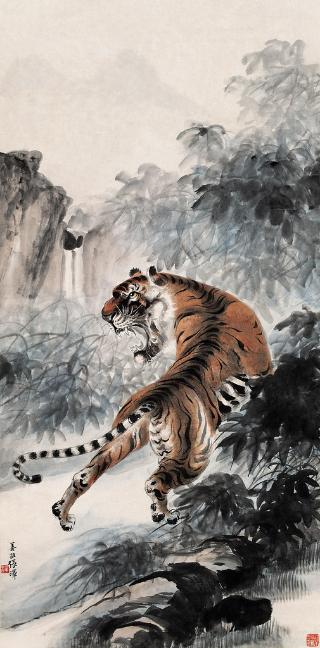
Dragons and Tigers in Chinese Art
The interplay between dragons and tigers in Chinese artChinese art encompasses a vast array of forms and influences. It has a rich history that dates back over 5,000 years and is characterized by unique regional, philosophical, and political influences that have evolved over millennia. Ancient Era The origins of Chinese art trace back to prehistoric times, highlighted by significant archaeological discoveries. These findings include pottery, jade carvings, and More is rich with symbolic meaning. These two majestic creatures often appear together, embodying powerful yet complementary forces.
Duality and Balance of Dragon and Tigers
In Chinese culture, the dragon and the tiger symbolize the balance of opposing yet harmonious forces. The dragon, often associated with the sky, water, and the yang (active) energy, represents power, authority, and wisdom.
In contrast, the tiger, linked with the earth and the yin (passive) energy, embodies strength, courage, and ferocity. Together, they illustrate the dynamic balance between these forces, similar to the concept of yin and yang.
This duality signifies harmony in the universe, where contrasting elements coexist and complement each other.
Artistic Depictions of Dragon and Tiger
Artists have long depicted dragons and tigers together, creating works that highlight their symbolic relationship. Here are some examples:
- Temple Murals at Longshan Temple: Many Chinese temples, such as Longshan Temple in Taipei, feature murals and carvings of dragons and tigers. These artistic depictions are not only visually striking but also carry deep spiritual meaning. The murals often show the dragon and tiger in dynamic poses, symbolizing protection and the harmonious coexistence of opposites.
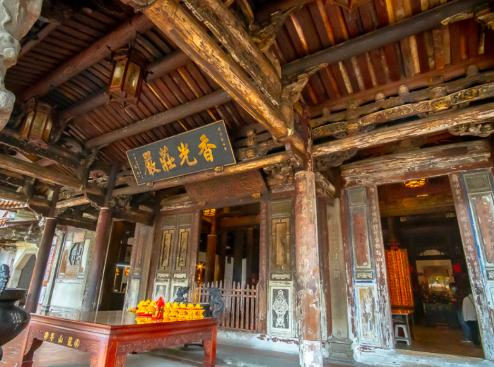
- Feng ShuiFeng Shui, an ancient Chinese practice, focuses on harmonizing individuals with their surrounding environment. Rooted in Taoist philosophy, it emphasizes the flow of energy (qi) and its impact on health, wealth, and overall well-being. Origins and History Feng Shui dates back thousands of years and has evolved through various Chinese dynasties. Initially used in the placement of tombs and homes, More Art: In Feng ShuiFeng Shui, an ancient Chinese practice, focuses on harmonizing individuals with their surrounding environment. Rooted in Taoist philosophy, it emphasizes the flow of energy (qi) and its impact on health, wealth, and overall well-being. Origins and History Feng Shui dates back thousands of years and has evolved through various Chinese dynasties. Initially used in the placement of tombs and homes, More, the dragon and the tiger are significant symbols often used to balance energies in a space. Traditional Feng ShuiFeng Shui, an ancient Chinese practice, focuses on harmonizing individuals with their surrounding environment. Rooted in Taoist philosophy, it emphasizes the flow of energy (qi) and its impact on health, wealth, and overall well-being. Origins and History Feng Shui dates back thousands of years and has evolved through various Chinese dynasties. Initially used in the placement of tombs and homes, More artworks frequently depict a green dragon on the left and a white tiger on the right, representing the ideal balance of energy in an environment. These pieces use detailed and balanced compositions to convey the harmony and balance these creatures bring.
These representations highlight the powerful individual attributes of each creature and emphasize their complementary nature. They reflect a cultural and philosophical understanding of harmony in the natural and spiritual worlds.
The Tiger in Folk Art and Popular Styles
Tigers hold a prominent place in Chinese folk artFolk art represents the creative expressions of ordinary people, often rooted in community traditions and cultural practices. It encompasses a wide range of artistic forms and styles, reflecting the everyday life, beliefs, and values of various cultures. Unlike fine art, folk art is typically created by self-taught artists, and its beauty lies in its simplicity and directness. Characteristics of Folk More, where they are celebrated for their symbolismSymbolism was a late 19th-century art movement of French, Belgian, and Russian origin. Poets and fine artists were seeking to represent absolute truths using metaphorical images in reaction against realism and naturalism. Content of both images and poetry were suggestive contents to express mystical ideas, emotions, and states of mind. Paul Gauguin, Nave Nave Mahana (1869) The term was coined More and cultural significance. These depictions vary regionally with diverse styles and artistic techniques.

Folk Art Traditions Around the Tiger
In Chinese folk artFolk art represents the creative expressions of ordinary people, often rooted in community traditions and cultural practices. It encompasses a wide range of artistic forms and styles, reflecting the everyday life, beliefs, and values of various cultures. Unlike fine art, folk art is typically created by self-taught artists, and its beauty lies in its simplicity and directness. Characteristics of Folk More, tigers are depicted with a mix of realismRealism is an art movement that emerged in the mid-19th century, emphasizing the depiction of subjects as they appear in everyday life. It rejects the idealized forms and dramatic expressions of Romanticism, focusing instead on accuracy, truthfulness, and the mundane aspects of the human experience. Realism strives to capture the world in a straightforward and unembellished manner. Gustave Courbet, The More and stylization, reflecting regional variations and cultural beliefs.
- Northern China: In regions like Shanxi and Shaanxi, tiger art is often bold and vibrant, characterized by strong lines and bright colors. These pictures emphasize the tiger’s fierce and protective nature, often seen in New Year paintings and paper cuttingsPaper cuttings, also known as papercutting, is an ancient and intricate art form that involves cutting paper into decorative designs. This technique has been practiced across various cultures, each bringing unique styles and themes to the art. From traditional motifs to modern interpretations, paper cuttings offer a fascinating glimpse into cultural heritage and artistic creativity. History and Origins The origins More meant to ward off evil spirits.
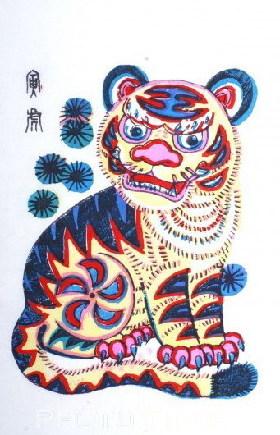
- Southern China: In areas such as Guangdong and Fujian, tigers are portrayed with more delicate lines and softer colors, reflecting the subtler artistic traditions of these regions. These tigers might appear in folk embroidery and potteryPottery, one of the most ancient and functional art forms, bridges the gap between utilitarian objects and expressive artwork. This craft has been practiced for thousands of years, evolving across cultures and epochs. The world of pottery is vast and varied, ranging from simple earthenware to ornate porcelain. Chinese Ming dynasty blue-and-white porcelain dish with a dragon The Basics of More, showcasing their importance in daily life and local customs.
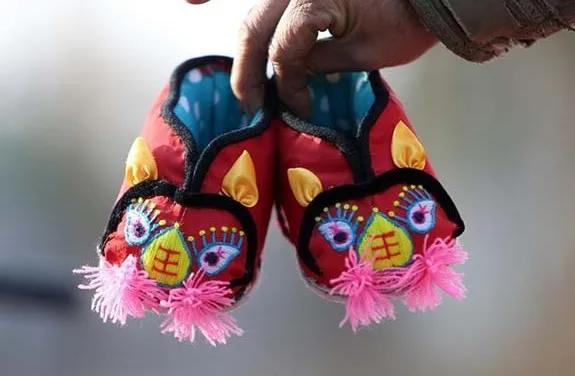
- Yunnan Province: Known for its ethnic diversity, Yunnan features tigers in various folk artFolk art represents the creative expressions of ordinary people, often rooted in community traditions and cultural practices. It encompasses a wide range of artistic forms and styles, reflecting the everyday life, beliefs, and values of various cultures. Unlike fine art, folk art is typically created by self-taught artists, and its beauty lies in its simplicity and directness. Characteristics of Folk More forms, including the intricate textiles of the Bai and Yi peoples. These depictions often include elaborate patterns and symbolic elements unique to each ethnic group, highlighting the tiger’s role in local folkloreFolklore in art draws from the rich oral traditions, legends, and customs passed down through generations. These stories and motifs provide a window into the cultural identity and collective wisdom of various communities, making them a vital source of inspiration for artists worldwide. European Folklore European folklore encompasses a wide array of tales and characters that have left a lasting More and rituals.
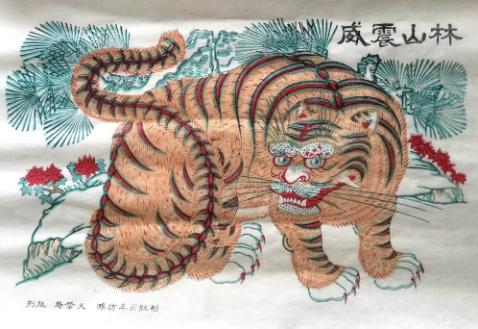
Popular Chinese Art Styles of the Tiger
In contemporary art, traditional tiger motifs are adapted to fit modern aesthetics and cultural contexts.
- Street ArtStreet art transforms public spaces into dynamic canvases, blending creativity with social commentary. From graffiti to murals, this art form engages with urban environments, reflecting the pulse of the community and often challenging societal norms. Street art has evolved from its rebellious roots into a respected and influential form of artistic expression. Origins and Evolution Street art's origins lie in More: Modern street artists often incorporate traditional tiger imagery into their murals, blending classic motifs with urban styles. For example, artist Hua Tunan combines traditional Chinese inkInk, a liquid or paste used for writing, drawing, and printing, has played a crucial role in communication and artistic expression throughout history. Made from various pigments and dyes, ink allows for the transfer of text and images onto surfaces such as paper, fabric, and other materials. Types of Ink There are several types of ink, each serving different purposes More techniques with graffitiGraffiti refers to writings or drawings made on a wall or other surface, usually in public view, without permission and within the realm of property law violations. Originating as a form of street art, graffiti has evolved into a complex form of expression that includes various styles, techniques, and motivations. This form of art has been a subject of controversy, More art, creating dynamic murals that bring ancient tiger symbols into the contemporary urban landscape.
- Fashion and Design: Designers frequently use tiger motifs in clothing, accessories, and home decor, reinterpreting traditional patterns for modern tastes. High-end fashion brands and local designers alike draw inspiration from historical tiger imagery, infusing their creations with cultural significance and contemporary flair.
- Digital ArtDigital art refers to a range of artistic works and practices that use digital technology as an essential part of the creative or presentation process. Since the 1970s, various names have been used to describe the process, including computer art and multimedia art. Digital art is itself placed under the larger umbrella term of new media art. The digital art More: Digital artists reinterpret traditional tiger motifs using modern tools and techniques. Artists like Victo Ngai, known for her intricate and imaginative illustrations, often incorporate elements of Chinese folkloreFolklore in art draws from the rich oral traditions, legends, and customs passed down through generations. These stories and motifs provide a window into the cultural identity and collective wisdom of various communities, making them a vital source of inspiration for artists worldwide. European Folklore European folklore encompasses a wide array of tales and characters that have left a lasting More and mythologyMythology in art taps into the rich stories and symbols from ancient cultures. These narratives shape our understanding of history, morality, and human nature, offering a profound connection between the past and the present. From the ancient Greeks to the Norse sagas, mythological themes have deeply influenced artistic expression. Greek Mythology Greek mythology is one of the most popular sources More, including tigers, into her digital works, blending tradition with innovation.
These adaptations of tiger motifs in contemporary art forms illustrate the versatility of this powerful symbol. By merging traditional themes with modern techniques, artists keep the cultural significance of the tiger alive and relevant.
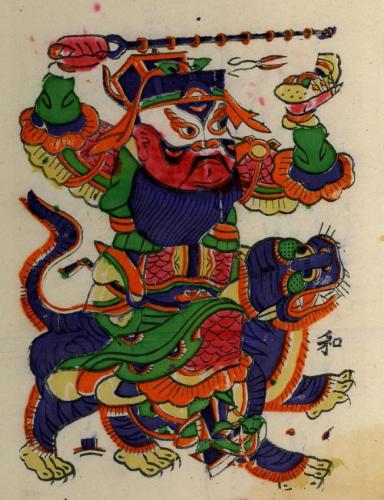
The Everlasting Roar: Conclusion on Tigers in Chinese Art
From ancient depictions in bronze and jadeJade, a precious gemstone highly esteemed in various cultures, particularly in East Asia, symbolizes purity, serenity, and longevity. It has been used for thousands of years in art, jewelry, and ritual objects. Types of Jade There are two primary types of jade, each with distinct characteristics and sources. Unworked jade Nephrite • Composition: Composed mainly of calcium, magnesium, and iron. More to contemporary digital interpretations, the tiger remains a powerful symbol of strength, courage, and protection. This motif showcases the ability of Chinese artChinese art encompasses a vast array of forms and influences. It has a rich history that dates back over 5,000 years and is characterized by unique regional, philosophical, and political influences that have evolved over millennia. Ancient Era The origins of Chinese art trace back to prehistoric times, highlighted by significant archaeological discoveries. These findings include pottery, jade carvings, and More to adapt and evolve while preserving its rich heritage.
As we explore the various artistic expressions of the tiger, we see a creature that not only embodies fierce beauty but also connects deeply with the spiritual and philosophical beliefs of China.
The tiger’s roar, echoing through centuries of art, reminds us of the enduring power of cultural symbols.
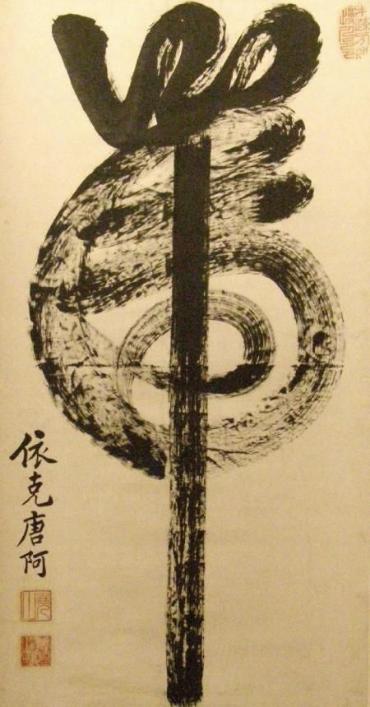
FAQ
Q: What is the significance of tigers in Chinese artChinese art encompasses a vast array of forms and influences. It has a rich history that dates back over 5,000 years and is characterized by unique regional, philosophical, and political influences that have evolved over millennia. Ancient Era The origins of Chinese art trace back to prehistoric times, highlighted by significant archaeological discoveries. These findings include pottery, jade carvings, and More?
A: Tigers in Chinese artChinese art encompasses a vast array of forms and influences. It has a rich history that dates back over 5,000 years and is characterized by unique regional, philosophical, and political influences that have evolved over millennia. Ancient Era The origins of Chinese art trace back to prehistoric times, highlighted by significant archaeological discoveries. These findings include pottery, jade carvings, and More symbolize power, protection, and courage. They are revered as guardians against evil spirits and are often depicted in various forms of artwork. From ancient Chinese artChinese art encompasses a vast array of forms and influences. It has a rich history that dates back over 5,000 years and is characterized by unique regional, philosophical, and political influences that have evolved over millennia. Ancient Era The origins of Chinese art trace back to prehistoric times, highlighted by significant archaeological discoveries. These findings include pottery, jade carvings, and More to modern interpretations, the tiger remains a central figure. Its majestic and fierce nature captures the essence of strength in Chinese culture.
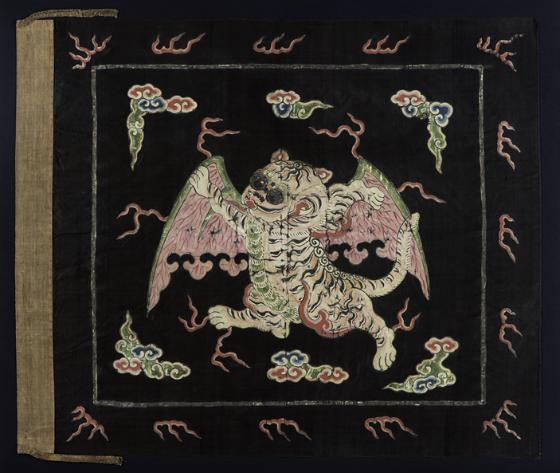
Q: How are tigers depicted in ancient Chinese artChinese art encompasses a vast array of forms and influences. It has a rich history that dates back over 5,000 years and is characterized by unique regional, philosophical, and political influences that have evolved over millennia. Ancient Era The origins of Chinese art trace back to prehistoric times, highlighted by significant archaeological discoveries. These findings include pottery, jade carvings, and More?
A: In ancient Chinese artChinese art encompasses a vast array of forms and influences. It has a rich history that dates back over 5,000 years and is characterized by unique regional, philosophical, and political influences that have evolved over millennia. Ancient Era The origins of Chinese art trace back to prehistoric times, highlighted by significant archaeological discoveries. These findings include pottery, jade carvings, and More, tigers are often portrayed with bold lines and a sense of movement, reflecting their powerful and dynamic nature. These depictions can be found on bronze vessels, potteryPottery, one of the most ancient and functional art forms, bridges the gap between utilitarian objects and expressive artwork. This craft has been practiced for thousands of years, evolving across cultures and epochs. The world of pottery is vast and varied, ranging from simple earthenware to ornate porcelain. Chinese Ming dynasty blue-and-white porcelain dish with a dragon The Basics of More, and jadeJade, a precious gemstone highly esteemed in various cultures, particularly in East Asia, symbolizes purity, serenity, and longevity. It has been used for thousands of years in art, jewelry, and ritual objects. Types of Jade There are two primary types of jade, each with distinct characteristics and sources. Unworked jade Nephrite • Composition: Composed mainly of calcium, magnesium, and iron. More carvings. The ancient artists emphasized the tiger’s strength and its role as a protector. These artworks highlight the tiger’s esteemed place in Chinese mythologyMythology in art taps into the rich stories and symbols from ancient cultures. These narratives shape our understanding of history, morality, and human nature, offering a profound connection between the past and the present. From the ancient Greeks to the Norse sagas, mythological themes have deeply influenced artistic expression. Greek Mythology Greek mythology is one of the most popular sources More and folkloreFolklore in art draws from the rich oral traditions, legends, and customs passed down through generations. These stories and motifs provide a window into the cultural identity and collective wisdom of various communities, making them a vital source of inspiration for artists worldwide. European Folklore European folklore encompasses a wide array of tales and characters that have left a lasting More.
Q: What are the characteristics of Chinese tiger folk artFolk art represents the creative expressions of ordinary people, often rooted in community traditions and cultural practices. It encompasses a wide range of artistic forms and styles, reflecting the everyday life, beliefs, and values of various cultures. Unlike fine art, folk art is typically created by self-taught artists, and its beauty lies in its simplicity and directness. Characteristics of Folk More?
A: Chinese tiger folk artFolk art represents the creative expressions of ordinary people, often rooted in community traditions and cultural practices. It encompasses a wide range of artistic forms and styles, reflecting the everyday life, beliefs, and values of various cultures. Unlike fine art, folk art is typically created by self-taught artists, and its beauty lies in its simplicity and directness. Characteristics of Folk More typically features vibrant colors and stylized designs. The artwork often includes bold lines and exaggerated features to emphasize the tiger’s fierce nature. Regional variations exist, with northern styles being more robust and southern styles being more delicate. This form of art celebrates the tiger’s cultural significance in daily life.
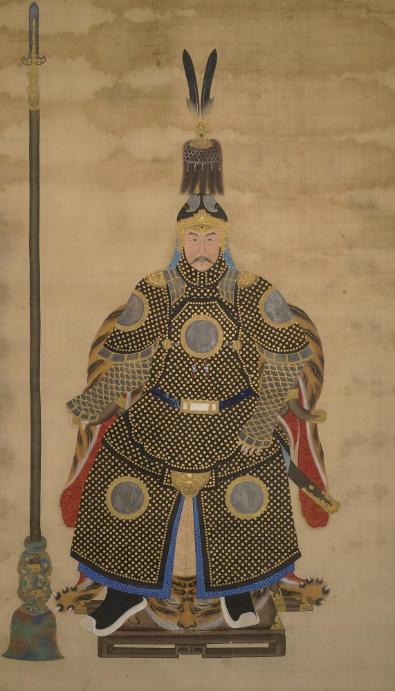
Q: How is the white tiger represented in Chinese artChinese art encompasses a vast array of forms and influences. It has a rich history that dates back over 5,000 years and is characterized by unique regional, philosophical, and political influences that have evolved over millennia. Ancient Era The origins of Chinese art trace back to prehistoric times, highlighted by significant archaeological discoveries. These findings include pottery, jade carvings, and More?
A: The white tiger in Chinese artChinese art encompasses a vast array of forms and influences. It has a rich history that dates back over 5,000 years and is characterized by unique regional, philosophical, and political influences that have evolved over millennia. Ancient Era The origins of Chinese art trace back to prehistoric times, highlighted by significant archaeological discoveries. These findings include pottery, jade carvings, and More, often depicted with red accents, symbolizes purity and protection. Known as Bai Hu, it represents the West and autumn in Chinese mythologyMythology in art taps into the rich stories and symbols from ancient cultures. These narratives shape our understanding of history, morality, and human nature, offering a profound connection between the past and the present. From the ancient Greeks to the Norse sagas, mythological themes have deeply influenced artistic expression. Greek Mythology Greek mythology is one of the most popular sources More. Artists use delicate brushworkMasterful brushwork is often the defining feature of great artists, where the brush becomes an extension of their arm, allowing paint to flow effortlessly onto the canvas. These artists demonstrate a profound understanding of their medium, knowing precisely when to apply thick, textured strokes or smooth, delicate ones. Their skill extends beyond mere color application; it's about the artistry of More to highlight its majestic appearance. Red elements are added to create a striking contrast, enhancing its visual impact.
Q: What themes are explored in Chinese dragon and tiger art?
A: Chinese dragon and tiger art explores the balance between opposing forces. The dragon symbolizes power and wisdom, while the tiger represents strength and courage. Together, they embody the harmony of yin and yang. This theme is prevalent in various art forms, from paintings to sculptures.
Q: How do contemporary artists incorporate tigers into Chinese fantasy art?
A: Contemporary artists blend traditional Chinese motifs with imaginative elements in Chinese fantasy art. Tigers are often depicted in surreal landscapes or alongside mythical creatures. This fusion creates unique and visually striking pieces. These artworks capture the essence of the tiger while adding a modern twist.
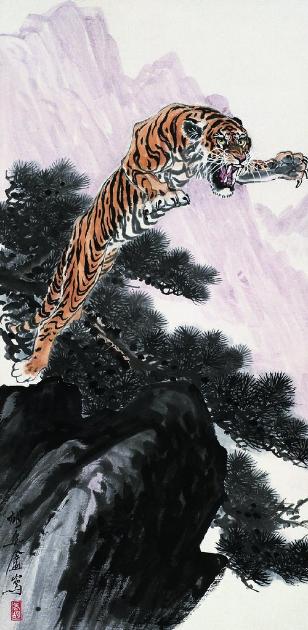
Q: What is the appeal of tiger tattoos inspired by Chinese artChinese art encompasses a vast array of forms and influences. It has a rich history that dates back over 5,000 years and is characterized by unique regional, philosophical, and political influences that have evolved over millennia. Ancient Era The origins of Chinese art trace back to prehistoric times, highlighted by significant archaeological discoveries. These findings include pottery, jade carvings, and More?
A: Tiger tattoos inspired by Chinese artChinese art encompasses a vast array of forms and influences. It has a rich history that dates back over 5,000 years and is characterized by unique regional, philosophical, and political influences that have evolved over millennia. Ancient Era The origins of Chinese art trace back to prehistoric times, highlighted by significant archaeological discoveries. These findings include pottery, jade carvings, and More are popular for their powerful symbolismSymbolism was a late 19th-century art movement of French, Belgian, and Russian origin. Poets and fine artists were seeking to represent absolute truths using metaphorical images in reaction against realism and naturalism. Content of both images and poetry were suggestive contents to express mystical ideas, emotions, and states of mind. Paul Gauguin, Nave Nave Mahana (1869) The term was coined More and aesthetic appeal. They represent strength, courage, and protection. Artists often incorporate traditional elements like dragons or mythical scenes. These tattoos are a blend of ancient symbolismSymbolism was a late 19th-century art movement of French, Belgian, and Russian origin. Poets and fine artists were seeking to represent absolute truths using metaphorical images in reaction against realism and naturalism. Content of both images and poetry were suggestive contents to express mystical ideas, emotions, and states of mind. Paul Gauguin, Nave Nave Mahana (1869) The term was coined More and modern body art.
Q: How are tigers depicted in Japanese drawings influenced by Chinese artChinese art encompasses a vast array of forms and influences. It has a rich history that dates back over 5,000 years and is characterized by unique regional, philosophical, and political influences that have evolved over millennia. Ancient Era The origins of Chinese art trace back to prehistoric times, highlighted by significant archaeological discoveries. These findings include pottery, jade carvings, and More?
A: Japanese tiger drawings influenced by Chinese artChinese art encompasses a vast array of forms and influences. It has a rich history that dates back over 5,000 years and is characterized by unique regional, philosophical, and political influences that have evolved over millennia. Ancient Era The origins of Chinese art trace back to prehistoric times, highlighted by significant archaeological discoveries. These findings include pottery, jade carvings, and More combine delicate lines with strong, dynamic forms. These artworks reflect the tiger’s powerful presence and graceful movements. The influence of Chinese techniques is evident in the brushworkMasterful brushwork is often the defining feature of great artists, where the brush becomes an extension of their arm, allowing paint to flow effortlessly onto the canvas. These artists demonstrate a profound understanding of their medium, knowing precisely when to apply thick, textured strokes or smooth, delicate ones. Their skill extends beyond mere color application; it's about the artistry of More and composition. This cross-cultural exchange enriches the artistic portrayal of tigers.
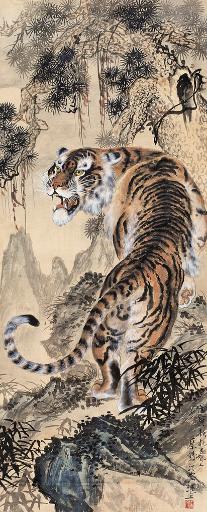
Q: What distinguishes Chinese tiger dragon art?
A: Chinese tiger dragon art stands out for its portrayal of the harmonious relationship between these two powerful creatures. The tiger symbolizes earthly strength, while the dragon represents celestial power. Artists depict them together to illustrate balance and duality. This theme is central to many traditional and contemporary Chinese artworks.
Q: How is the tiger represented in Chinese traditional art?
A: In Chinese traditional art, the tiger is often depicted with intricate details and symbolic elements. Artists use fine brushworkMasterful brushwork is often the defining feature of great artists, where the brush becomes an extension of their arm, allowing paint to flow effortlessly onto the canvas. These artists demonstrate a profound understanding of their medium, knowing precisely when to apply thick, textured strokes or smooth, delicate ones. Their skill extends beyond mere color application; it's about the artistry of More to capture its fur and expressive features. The tiger is shown in dynamic poses, emphasizing its role as a protector. This representation highlights its cultural importance and enduring legacy.
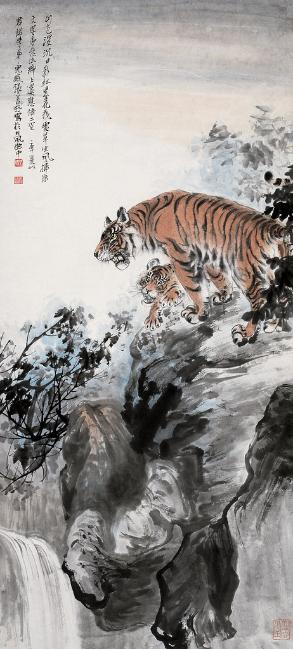
Sources
Kim, H. Y. (n.d.). East Asian Cultural Exchange in Tiger and Dragon Paintings. The Metropolitan Museum of Art, Heilbrunn Timeline of Art History. Retrieved from https://www.metmuseum.org/toah/hd/tidra/hd_tidra.htm
Issuu. (n.d.). Perceptions and Representations of the Tiger in East Asian Art. Retrieved from https://issuu.com/museumofkorea/docs/nmk_v43/s/12345669
The Metropolitan Museum of Art. (n.d.). Tiger, Western Zhou Dynasty. Retrieved from https://www.metmuseum.org/art/collection/search/44779
Artisoo. (2013, March 13). Chinese Tiger in PaintingPainting is a fundamental form of visual art that has been practiced for thousands of years. It involves applying pigment to a surface such as canvas, paper, or a wall. Painting can be explored through various styles, techniques, and mediums, each offering unique possibilities for expression and creativity. Historical Background • Ancient Beginnings: The history of painting dates back to More and Its Symbolic Meaning. Retrieved from https://www.artisoo.com/blog/chinese-tiger-in-painting-and-its-symbolic-meaning
The Metropolitan Museum of Art. (2001). Han Dynasty (206 B.C.–220 A.D.). Retrieved from https://www.metmuseum.org/toah/hd/hand/hd_hand.htm
Wikimedia Commons. (n.d.). Category: Tigers in art of China. Retrieved from https://commons.wikimedia.org/wiki/Category:Tigers_in_art_of_China
MythologyMythology in art taps into the rich stories and symbols from ancient cultures. These narratives shape our understanding of history, morality, and human nature, offering a profound connection between the past and the present. From the ancient Greeks to the Norse sagas, mythological themes have deeply influenced artistic expression. Greek Mythology Greek mythology is one of the most popular sources More Worldwide. (n.d.). The Legend of the White Tiger in Chinese MythologyMythology in art taps into the rich stories and symbols from ancient cultures. These narratives shape our understanding of history, morality, and human nature, offering a profound connection between the past and the present. From the ancient Greeks to the Norse sagas, mythological themes have deeply influenced artistic expression. Greek Mythology Greek mythology is one of the most popular sources More. Retrieved from https://www.mythologyworldwide.com/the-legend-of-the-white-tiger-in-chinese-mythology
The Metropolitan Museum of Art. (2004). Traditional Chinese PaintingPainting is a fundamental form of visual art that has been practiced for thousands of years. It involves applying pigment to a surface such as canvas, paper, or a wall. Painting can be explored through various styles, techniques, and mediums, each offering unique possibilities for expression and creativity. Historical Background • Ancient Beginnings: The history of painting dates back to More in the Twentieth Century. Retrieved from https://www.metmuseum.org/toah/hd/cptg/hd_cptg.htm
The Metropolitan Museum of Art. (2003). The Kano School of PaintingPainting is a fundamental form of visual art that has been practiced for thousands of years. It involves applying pigment to a surface such as canvas, paper, or a wall. Painting can be explored through various styles, techniques, and mediums, each offering unique possibilities for expression and creativity. Historical Background • Ancient Beginnings: The history of painting dates back to More. Retrieved from https://www.metmuseum.org/toah/hd/kano/hd_kano.htm
DailyArt Magazine. (2022, February 1). Year of the Tiger: Chinese New Year 2022. Retrieved from https://www.dailyartmagazine.com/chinese-new-year-tiger/
Heilbrunn Timeline of Art History. (2000). Chinese Cloisonné. The Metropolitan Museum of Art. Retrieved from https://collection.powerhouse.com.au/object/549961
The Metropolitan Museum of Art. (2001). Southern Song Dynasty (1127–1279). Retrieved from https://www.metmuseum.org/toah/hd/ssong/hd_ssong.htm
The Metropolitan Museum of Art. (2004). Nature in Chinese Culture. Retrieved from https://www.metmuseum.org/toah/hd/cnat/hd_cnat.htm
The Metropolitan Museum of Art. (2002). Yuan Dynasty (1271–1368). Retrieved from https://www.metmuseum.org/toah/hd/ynst/hd_ynst.htm
Get some art goodies, completely for free:
Chinese Paintings HD Wallpapers for Phone and Laptop: Free Download for Art Enthusiasts
Chinese Coloring Pages: Free Printable for Art Enthusiasts
Transform Your Screen: Free Impressionism Wallpapers for Phones and Desktops
Master Impressionist Color Palettes: Free Downloadable Cheat Sheet
Fun Learning: Color Theory for Kids Free Worksheet PDF
Boost Your Color Knowledge: Free Color Theory Worksheet PDF
My Color Personality Quiz: Artistic Insights for Creatives
You might enjoy reading further articles by Pigment Pool:
Bamboo Art: Picture Serenity through Chinese Brushwork
Yin-Yang Aesthetic: A Symbol Transcending Time and Culture
Mandala Therapy: Art Techniques to Soothe Anxiety and Stress
A brief history of colour pigments
Impressionism and Japonisme: How Japan Has Inspired Western Artists
Fine Art, Finer Returns: Building a Solid Art Investment Strategy in 2024
How to Create Post-Impressionism Art: Easy Steps to Vibrant Paintings
Guillaume Apollinaire, Surrealism and Today’s AI: Above Reality
Full Disclosure: Clicking on product links could mean a tiny commission for me, at no extra cost to you.
